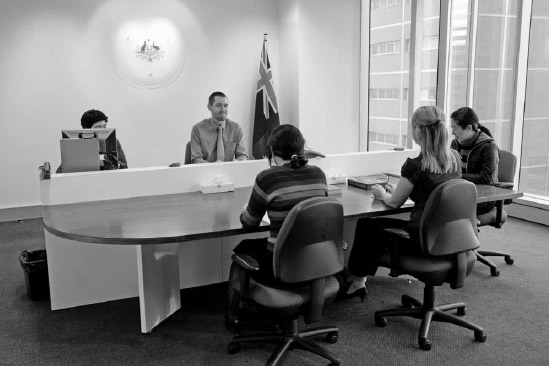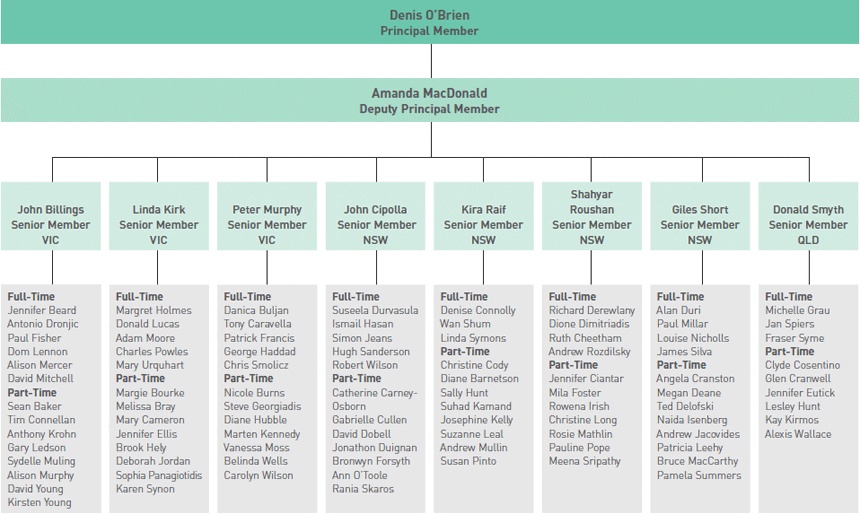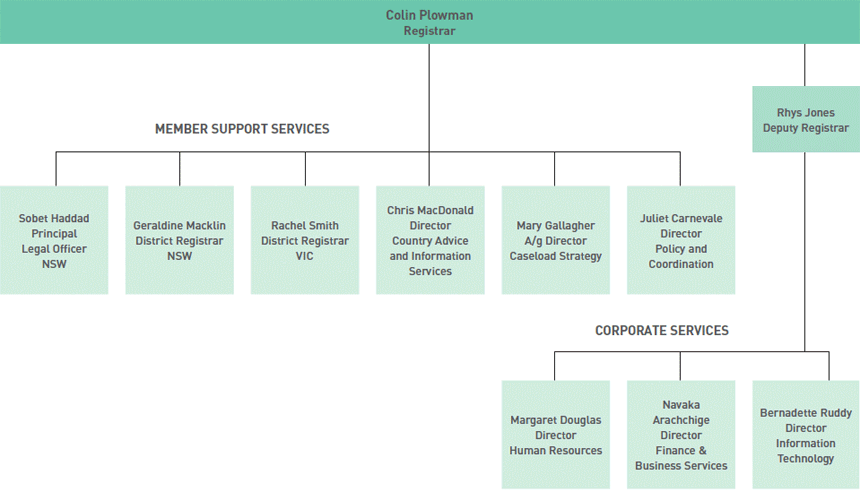Part 2 –The role of the tribunals
Contents
The Migration Review Tribunal (the MRT) and the Refugee Review Tribunal (the RRT) are statutory bodies providing a final, independent merits review of visa and visa-related decisions made by the Minister for Immigration and Citizenship (the Minister) or by officers of the Department of Immigration and Citizenship (the Department), acting as delegates of the Minister.
The tribunals are established under the Migration Act 1958. The tribunals’ jurisdictions, powers and procedures are set out in the Migration Act and the Migration Regulations 1994. The tribunals comprise members (appointed by the Governor-General under the Migration Act for fixed terms) and staff (appointed under the Migration Act and employed under the Public Service Act 1999).
All members and staff are cross-appointed to both tribunals and the tribunals operate as a single agency for the purposes of the Financial Management and Accountability Act 1997.
The MRT reviews a wide range of decisions in relation to visas other than protection visas.
The RRT reviews decisions in relation to protection visas.
A visa is required by anyone who is not an Australian citizen and who wishes to travel to, and remain in, Australia. The Migration Act and the Migration Regulations set out the criteria for visas. There are specific criteria which relate to the purpose of particular visas, and general criteria relating to matters such as health and character.
A visa is refused if a decision maker is not satisfied that a person meets the criteria for the visa. A visa may be cancelled if, for example, it was obtained by making false statements or if the visa holder has not abided by the conditions of the visa.
In reviewing a decision to refuse to grant or to cancel a visa, the tribunals are required to conduct a ‘merits review’ that is ‘independent, fair, just, economical, informal and quick’.
Merits review
Merits review is an administrative reconsideration of a case. A merits review body makes decisions within the same legislative framework as the primary decision maker, and may exercise all the powers and discretions conferred on the primary decision maker.
The principal objective of merits review is to ensure that the correct or preferable decision is reached in the particular case. The decision and reasons of a merits review body should also improve the general quality and consistency of decision making, and enhance openness and accountability of an area of government decision making.
The tribunals reconsider each case in light of the facts before them, the law and government policy. A decision made by a member in one case does not bind members in other cases but it is generally expected that a decision in a particular case would be consistent with other decisions in like matters.
The tribunals have the power to affirm the primary decision, vary the primary decision, set aside the primary decision and substitute a new decision, or remit (return) a matter to the Department for reconsideration with specific directions. For example, a matter may be ‘remitted’ if a member is satisfied that a visa applicant meets one or more of the criteria for the visa. The Department may then need to undertake further processing in relation to other requirements for the visa such as health, security and character.
Matters reviewed by the MRT
The MRT can review decisions relating to a wide range of visas. Reviewable decisions include decisions to refuse to grant visas, to cancel visas, to refuse to approve sponsors, and to refuse to approve a nominated position or business activity.
Bridging visas provide temporary lawful status to non-citizens in Australia, for example, while a temporary entrant is awaiting the outcome of an application for permanent residence. Visitor visas are for tourists and persons visiting relatives in Australia. Student visas are granted to persons enrolled at schools, colleges and universities in Australia. Temporary business visas are for persons whose proposed employment or business activities will contribute to the creation or maintenance of employment within Australia, the expansion of Australian trade, an improvement in links with international markets and/or greater competitiveness in the economy.
Permanent business visas are for successful business people, who obtain a substantial ownership interest in a new or existing business in Australia and actively participate in that business at a senior management level. Skilled visas are for persons in skilled occupations who have the education, skills and employability to contribute to the Australian economy.
Partner visas are for partners of Australian citizens or permanent residents. Family visas are for children, parents, remaining relatives (persons who have limited family contacts, other than relatives living in Australia), aged dependent relatives (elderly overseas relatives who have been financially supported by a close Australian relative for a reasonable period) and carers (persons who are able and willing to provide assistance needed by a relative in Australia).
Matters reviewed by the RRT
The RRT reviews decisions to refuse to grant or to cancel protection visas within Australia. The review of these decisions usually involves a consideration of whether or not the applicant is a person to whom Australia has protection obligations. This involves consideration of whether he or she is a ‘refugee’ within the meaning of the 1951 United Nations Convention Relating to the Status of Refugees (as amended by the 1967 UN Protocol Relating to the Status of Refugees) (the Convention).
The 1967 UN Protocol Relating to the Status of Refugees (the Protocol) removed the time and geographical limitation in the Convention’s definition of a refugee. The Convention now extends to all persons who are refugees because of events occurring at any time in any place. Australia became a signatory to the Refugees Convention in 1954 and to the Protocol in 1973.
The term ‘refugee’ is defined in Article 1A(2) of the Convention as amended by the Protocol, as a person who:
... owing to well-founded fear of being persecuted for reasons of race, religion, nationality, membership of a particular social group or political opinion, is outside the country of his nationality and is unable or, owing to such fear, is unwilling to avail himself of the protection of that country; or who, not having a nationality and being outside the country of his former habitual residence, is unable or, owing to such fear, is unwilling to return to it ...
Other provisions of the Convention may be relevant to an assessment of the entitlement to a protection visa.
A number of provisions of the Migration Act expressly qualify certain aspects of the Convention. These provisions focus principally on the concepts of persecution and the nature and seriousness of certain crimes relevant to the determination of whether Australia has protection obligations to an asylum seeker. Many aspects of the Convention, however, are not specifically defined by the legislation and must be interpreted in accordance with established legal principles.
Applying for review
Whenever a decision is made which is reviewable by the MRT or the RRT, the department is required by law to advise the person or persons involved of their review rights. This includes setting out who can apply for review, where an application for review can be made and the time limit within which the application must be made.
It is important that persons who receive a departmental decision consider the information about review rights carefully. The tribunals do not have discretion to accept an application for review which has been lodged outside the relevant time limit or by a person who is not entitled to apply for review.
Form M1 is the general MRT application form. Form M2 is the MRT application form for persons in immigration detention. Form R1 is the RRT application form. These forms are available on the MRT-RRT website or from the Sydney and Melbourne registries of the tribunals and the Adelaide, Brisbane and Perth registries of the Administrative Appeals Tribunal.
A fee is payable for all MRT applications except applications for review of bridging visa decisions (including any related decision to require a security) that are made by persons in immigration detention.
Changes to the tribunals’ fees took effect on 1 July 2011. For applications to the MRT lodged prior to 1 July 2011, a fee of $1,400 applied and payment of the fee could be waived if payment would cause severe financial hardship. For applications lodged on or after 1 July 2011, a fee of $1,540 applies and a reduced fee of $770 may be paid in cases of severe financial hardship.
There is no application fee when applying to the RRT. However, for applications to the RRT lodged before 1 July 2011, a $1,400 fee was payable if the RRT affirmed the primary decision. For applications lodged on or after 1 July 2011, a post-decision fee of $1,540 applies if the application is unsuccessful.
conduct of reviews
The tribunals are usually constituted by a single member. The member is required to conduct an independent review and reach an independent decision.
An applicant may appoint a representative to assist with his or her case. With very limited exceptions, only a registered migration agent can act as a representative or provide immigration assistance to an applicant before the tribunals. A significant proportion of applicants are not represented and tribunal procedures and information are designed to assist applicants who are not represented.
The applicant (or his or her representative) can request a copy of the documents before the tribunal and can at any time provide written submissions and written evidence.
A member must ensure that an applicant has the opportunity to address the issues arising in the review, particularly any information which may be the reason or part of the reason for affirming the decision under review. The tribunals can invite an applicant in writing or at hearing to comment on or respond to relevant information.
In most cases, the applicant is invited to attend a hearing to give oral evidence and present arguments on the issues arising in the review. The applicant can ask that an interpreter be provided, and can be accompanied by a representative and/or a friend, relative or support person. The applicant can also request that the tribunal take evidence from other persons.
The hearings do not have a strict procedure; however, evidence is usually taken under oath or affirmation. The member will explain the procedures and ask questions. The applicant may or may not choose to make a statement. Neither the Minister nor the Department is represented.
Hearings are usually held in person, but may also be held through video or telephone links. All hearings are audio recorded, and the applicant can request a copy of the recording.
MRT hearings must be open to the public, unless there is a public interest reason for conducting the hearing in private. All RRT hearings must be held in private.
Information available to assist applicants
The tribunals provide information to applicants about procedures and processes throughout a review, and publish a wide range of information which can assist applicants or those assisting applicants. Information which is available on the tribunal website at www.mrt-rrt.gov.au includes:
- Principal Member Directions on the conduct of reviews, putting information orally to applicants, management of detention cases and caseload and constitution arrangements
- the Guide to Refugee Law in Australia
- guidelines on the assessment of credibility, vulnerable persons, expert opinion evidence, quality decision making, the use of interpreters, gender considerations and referrals of cases for Ministerial intervention consideration
- Précis – a bulletin produced 11 times per year, which summarises selected tribunal decisions, court judgments, country advice and selected statistics
- country advice information on more than 90 countries
- forms, brochures and factsheets
- statistics on caseloads and the timeliness of reviews
- a processing times calculator
- the tribunals’ Service Charter
- a webpage specifically aimed at the needs of representatives
- a daily schedule for MRT and RRT hearings
Tribunal decisions are available on the AustLII website at www.austlii.edu.au. The tribunals currently publish at least 40% of decisions made. RRT decisions are edited to remove information which would identify an applicant or relatives of an applicant, as required by the Migration Act.
MRT decisions are published in full, as required by the Migration Act, unless the member has determined that publication of certain information or the applicant’s identity would not be in the public interest.

Decisions
The member may in some cases make an oral decision at the end of a hearing. In most cases, the member either allows time for further documents to be lodged or needs more time to consider the case.
In all cases, a written statement of decision and reasons is prepared and provided to the applicant and the Department.
Vision, purpose and values
The tribunals provide an independent and final merits review of decisions. The review must be fair, just, economical, informal and quick. We seek to treat all those with whom we deal with courtesy, respect and dignity.
The Tribunals’ Plan, Member Code of Conduct, Service Charter and Interpreters’ Handbook promote and uphold these values. All of these documents are available on the tribunals’ website. A membership chart of active members is at page 22. A staff organisational chart is at page 23. An overview of information about the tribunals is set out in ‘The tribunals at a glance’ at page 7.
Membership as at 1 July 2011

Note: Excludes members on leave of absence to the Independent Protection Assessment Office (IPAO) until 31 December 2012.
Text version of the Membership diagram
Staff Organisational Chart

Text version of the Membership diagram
![Australian Government - Migration Review Tribunal - Refugee Review Tribunal [header logo image]](img/header/img-hdr-logo.gif)
![Annual Report 2010-2011 [header text image]](img/header/img-hdr-ar-2010-2011.gif)
